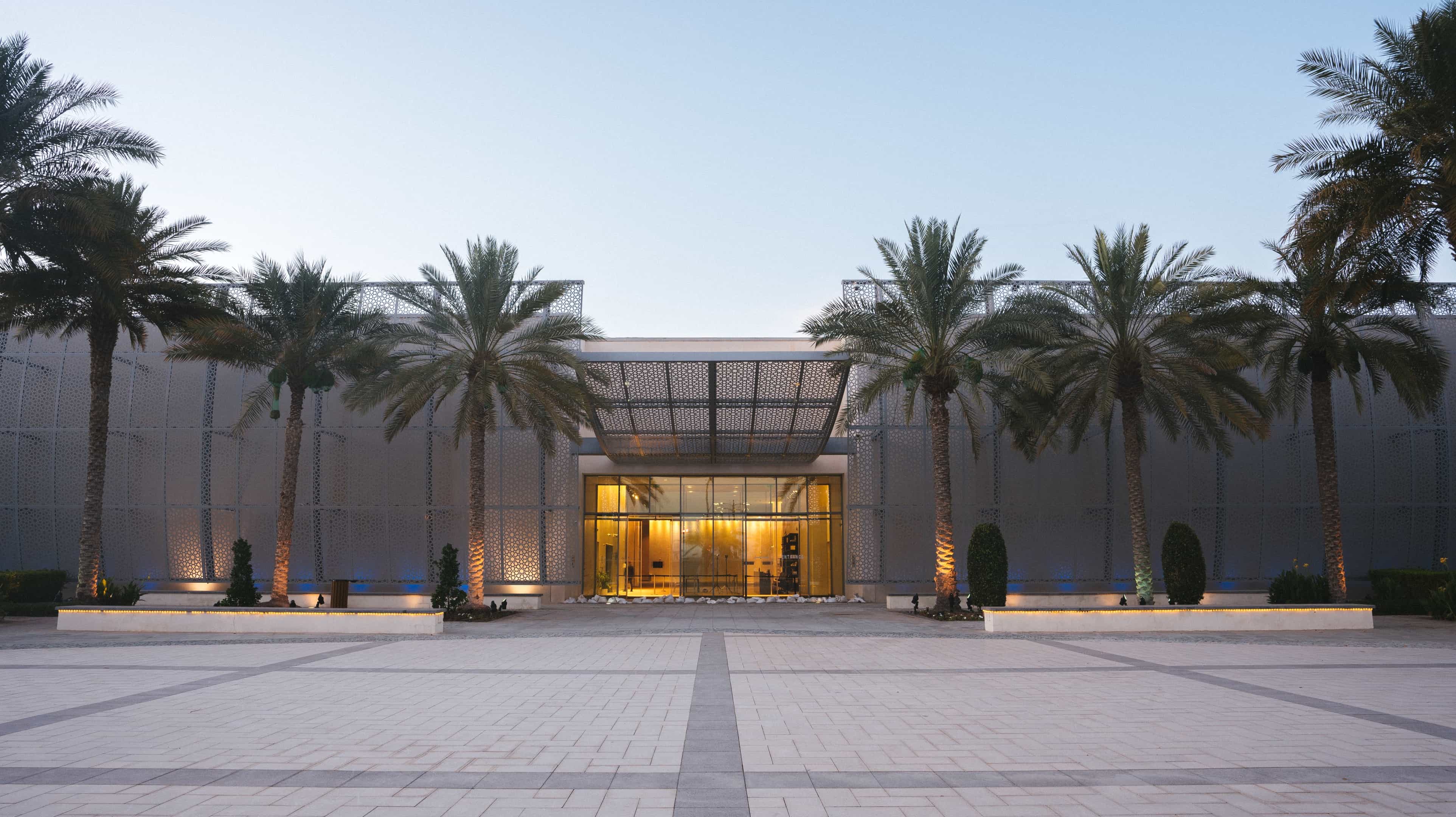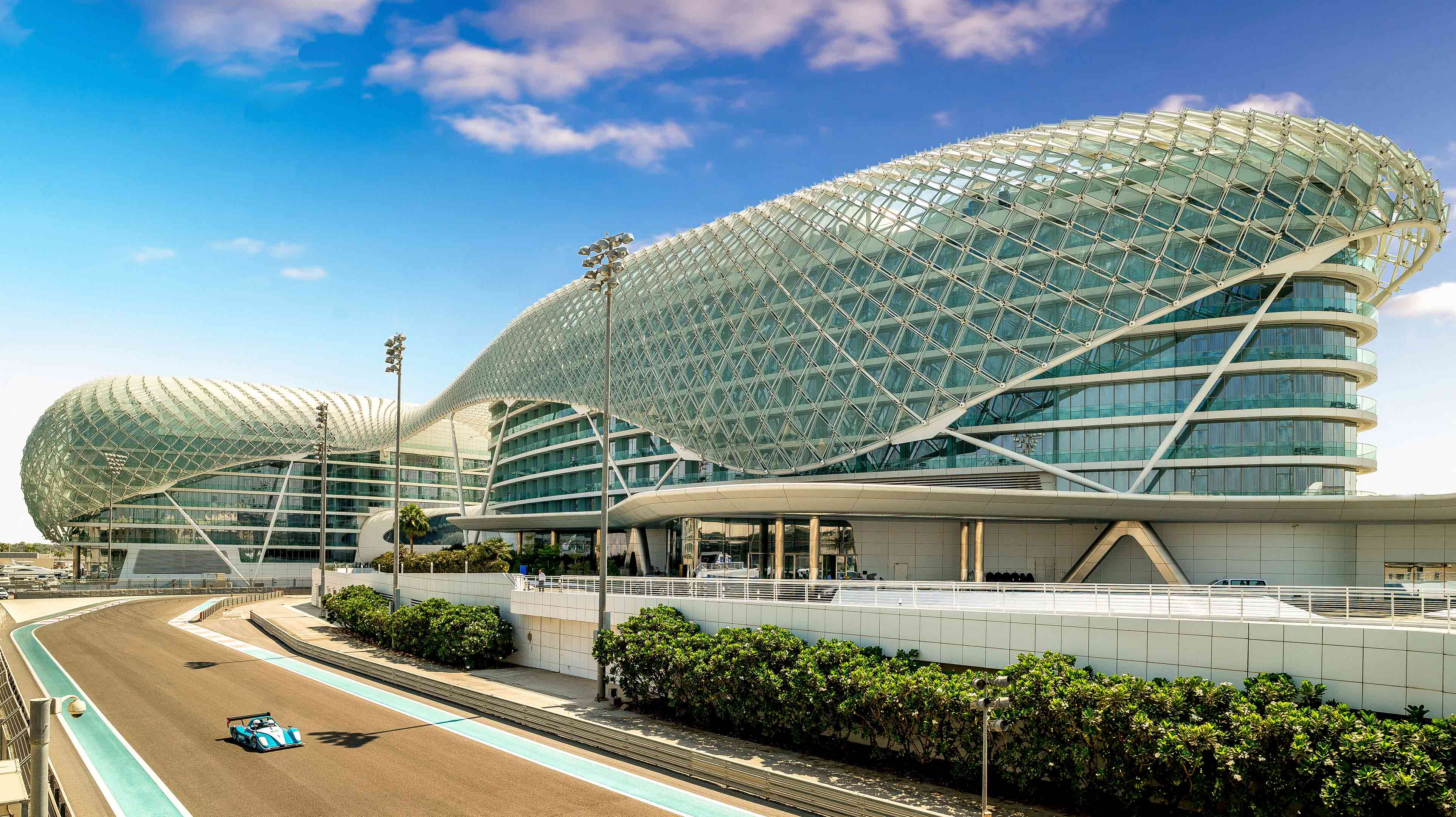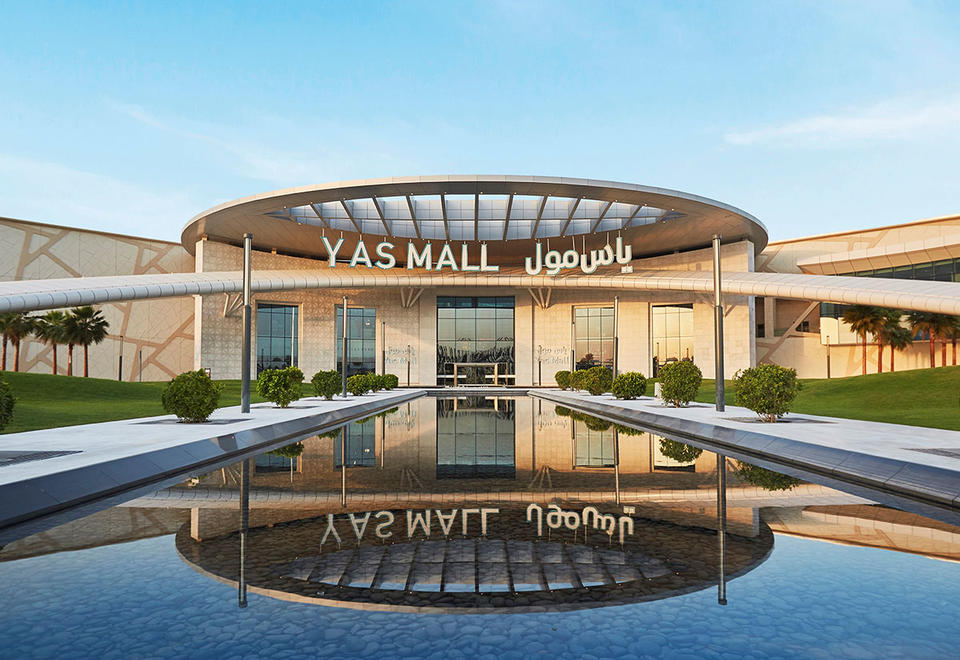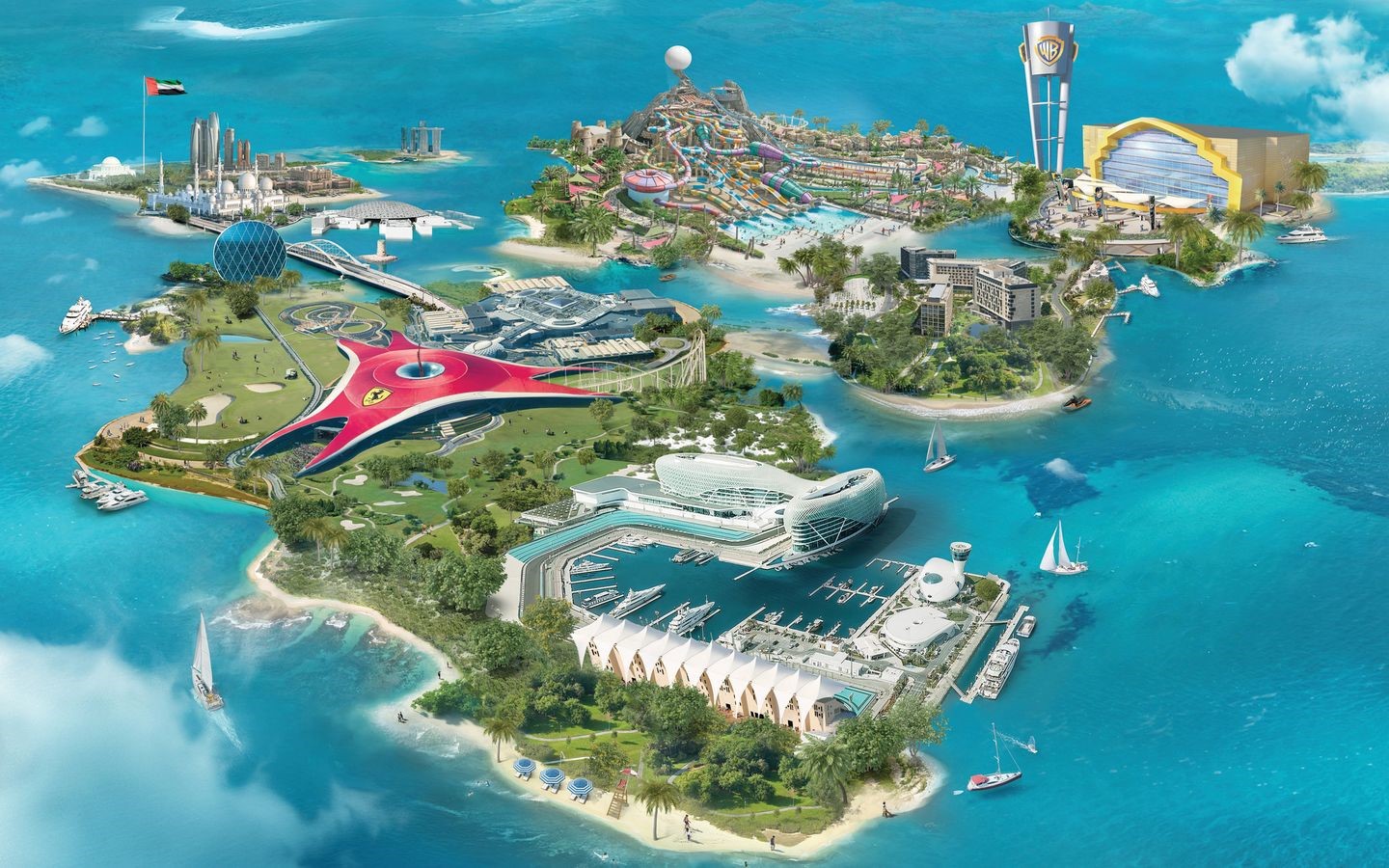

Abu Dhabi ([ˈabu ˈdaːbi], arabisch أبو ظبي, DMG Abū Ẓabī ‚Vater der Gazelle‘) ist die Hauptstadt des Emirats Abu Dhabi und der Vereinigten Arabischen Emirate (VAE).
Der Kern der Stadt mit ihren über 1,5 Millionen Einwohnern[1] befindet sich auf einer 70 Quadratkilometer großen Insel im Persischen Golf, im Mangrovengürtel. Mit dem Festland verbunden ist sie durch die Mussafa-Brücke, die al-Maqtaa-Brücke und die Sheikh-Zayed-Brücke. Die Hauptinsel ist von einem Kranz künstlich erweiterter oder neu aufgespülter Inseln umgeben, die zurzeit erst zum Teil bebaut sind und das Siedlungsgebiet erweitern.
An der dem offenen Meer zugewandten nordwestlichen Flanke der Insel befindet sich die Corniche, an der seit 2003 weiter Land gewonnen wurde. Am Nordende der Corniche befindet sich ein etwa ein Kilometer breiter und fünf Kilometer langer Streifen, den man aufgrund seiner verdichteten Bebauung als Stadtzentrum betrachten kann.Acht Kilometer westlich liegt die Insel Al-Futaisi.
阿布扎比(阿拉伯语:أبو ظبي,Abū Z̧abī;英语:Abu Dhabi)是阿拉伯联合酋长国之阿布扎比酋长国的首府,也是阿拉伯联合酋长国的首都。阿布扎比位于阿拉伯联合酋长国的中西边海岸,位于波斯湾的一个T字形岛屿上。阿布扎比于2006年人口大约为180万,而80%人口持有外国国籍。它是世界上外派员工生活费用最昂贵的城市之一,在阿联酋内仅次于迪拜[5]。 阿布扎比的殖民历史最早可以追溯至公元前3千年,当时在当地生活的都是游牧民族,以畜牧及捕渔为生。在阿布扎比附近艾因和哈菲特山周围也发现了一些史前人类遗址。
アブダビ市(アラビア語: أبو ظبي)は、アブダビ首長国の首都であると同時に、アラブ首長国連邦の首都でもある。
アブダビを首都として定めている現行の連邦憲法は、制定時は暫定憲法という位置付けだったため、アブダビも形式的には暫定首都という地位にあった。1996年にその暫定憲法が正式に連邦の恒久的な憲法として制定されたため、それに伴いアブダビも名実共に連邦の正式な首都としての地位を得た。
ドバイに次ぎ、同国第2の人口を有する。
Abu Dhabi (UK: /ˈæbuːˈdɑːbi/, US: /ˈɑːbuː/ ; Arabic: أَبُو ظَبْيٍ Abū Ẓabī Arabic pronunciation: [ɐˈbuˈðˤɑbi])[5] is the capital and the second-most populous city of the United Arab Emirates (after Dubai). The city of Abu Dhabi is located on an island in the Persian Gulf, off the Central West Coast. Most of the city and the Emirate reside on the mainland connected to the rest of the country. As of 2020, Abu Dhabi's urban area had an estimated population of 1.48 million,[6] out of 2.9 million in the emirate of Abu Dhabi, as of 2016.[7] Abu Dhabi Investment Authority, the world's 3rd largest sovereign wealth fund in 2020 is headquartered in the city,[8] while Abu Dhabi itself has over a trillion US dollars worth of assets under management in a combination of various sovereign wealth funds headquartered there.[9]
Abu Dhabi houses local and federal government offices and is the home of the United Arab Emirates Government and the Supreme Petroleum Council. The city is home to the President of the UAE, who is a member of the Al Nahyan family. Abu Dhabi's rapid development and urbanization, coupled with the massive oil and gas reserves and production and relatively high average income, have transformed it into a large, developed metropolis. It is the country's center of politics and industry, and a major culture and commerce center. Abu Dhabi accounts for about two-thirds of the roughly $400 billion UAE economy.[10]
Abou Dabi, parfois orthographié Abu Dhabi, Abou Dhabi ou Aboû DabîNote 1, en arabe أبو ظبي, ʼAbū Ẓaby, littéralement « Père de la gazelle »3, est la capitale de l'émirat d'Abou Dabi et des Émirats arabes unis4.
Bien que l'on trouve des traces de civilisation plusieurs millénaires avant notre ère, la zone n'a été habitée en permanence qu'à partir du XVIIIe siècle. Mais c'est au XXe siècle que la ville a connu une croissance importante, en grande partie grâce aux revenus du pétrole5.
Aujourd'hui, Abou Dabi qui compte près de 1,483 million habitants, est la troisième ville des Émirats arabes unis après Charjah et Dubaï. Elle est le centre politique et industriel de la fédération, et un centre culturel et commercial important dans le golfe Persique, du fait de sa position de capitale.
Abu Dhabi, o più correttamente 'Abū Ẓabiyy (in arabo: أبو ظبي), è la capitale degli Emirati Arabi Uniti e capitale dell'omonimo emirato.[1] Abu Dhabi si trova su un'isola a forma di T che si protende nel Golfo Persico dalla costa centro-occidentale. Nel 2014, la città vera e propria contava una popolazione di 1,5 milioni di persone.[2]
La città fu fondata nel 1791 dalla tribù beduina dei Banū Yās, che avevano occupato la regione, lasciando il Najd poiché in contrasto con i wahhabiti dell'Arabia.
Abu Dhabi ospita uffici del governo federale, è la sede del governo degli Emirati Arabi Uniti, sede della famiglia degli Emiri di Abu Dhabi e del Presidente degli Emirati Arabi Uniti, che proviene da questa famiglia. Il suo rapido sviluppo e l'urbanizzazione, accoppiata con il relativamente alto reddito medio della sua popolazione, ha trasformato la città in una grande e avanzata metropoli. Oggi la città è il centro del paese nelle attività politiche e industriali, oltre ad essere un importante centro culturale e commerciale. Abu Dhabi rappresenta circa i due terzi dell'economia degli Emirati Arabi Uniti con circa 400 miliardi di dollari statunitensi.[3]
Abu Dhabi è la quarta città più cara per i lavoratori espatriati nella regione, nel 2014 è stata la 68ª città più costosa al mondo.
Oltrepassando oltre 300 città, tra cui Tokyo, Basilea, Monaco e Vienna, la capitale degli Emirati Arabi Uniti è tornata in cima alla lista come la città più sicura al mondo. L'indice di sicurezza dell'emirato è cresciuto da 86,46 punti nel primo semestre del 2017 a 88,26 punti nei primi sei mesi del 2018[4].
Abu Dabi1 (en árabe, أبوظبي ʼAbū Ẓabī, literalmente 'Padre de una gacela')2 es la capital y segunda ciudad más poblada de los Emiratos Árabes Unidos, así como del emirato homónimo. Abu Dabi se encuentra en una isla en forma de T al sureste del golfo Pérsico. El emirato en sí cubre una superficie de 67 340 km² y tenía una población de 860 000 habitantes en 2007.3
Abu Dabi aloja importantes oficinas del gobierno federal y es la sede del Gobierno de los Emiratos Árabes Unidos, así como sede de la familia real emiratí. Abu Dabi ha crecido hasta convertirse en una metrópolis cosmopolita. Su rápido desarrollo y urbanización, junto con la relativamente elevada renta media de su población, han impulsado una transformación de Abu Dabi en la última década del siglo XX y primera del XXI. A comienzos del siglo XXI, la ciudad es el centro de la vida política del país, de las actividades industriales y de gran tradición cultural. Además, es el centro comercial debido a su posición como capital. Abu Dabi genera por sí sola el 15% del PIB de los Emiratos Árabes Unidos.45 La capital emiratí es sede de importantes instituciones financieras, como el Abu Dhabi Securities Exchange, el Banco Central de los Emiratos Árabes Unidos, y la sede corporativa de muchas empresas nacionales y multinacionales. Uno de los mayores productores mundiales de petróleo, Abu Dabi ha tratado de diversificar su economía en los últimos años a través de inversiones en los servicios financieros y turismo. Abu Dabi es la tercera ciudad más cara en la región y la 26.ª ciudad más cara del mundo.6
Aunque según las normas de transcripción del árabe debería escribirse en español Abu Zabi,[cita requerida] la Academia de la Lengua recomienda la forma Abu Dabi.[cita requerida] El gentilicio recomendado es abudabí.
А́бу́-Да́би[3][4][5] (араб. أَبو ظَبِي [ɐˈbuˈðˤɑbi][6]) — столица Объединённых Арабских Эмиратов и эмирата Абу-Даби. Политический, промышленный, торговый и культурный центр страны, его вклад в ВВП ОАЭ превышает 56 % (2008). Население города 1 483 000 жителей[1] (2020). Ранее город назывался А́бу-За́би[7][8].
В Абу-Даби находятся местные и федеральные правительственные учреждения, а также резиденция правительства Объединённых Арабских Эмиратов и Высшего нефтяного совета. В городе проживает президент ОАЭ, который является членом семьи Аль Нахайян. Быстрое развитие и урбанизация Абу-Даби в сочетании с огромными запасами и добычей нефти и газа, а также относительно высоким средним уровнем дохода его населения превратили город в крупный и развитый мегаполис. Сегодня город является центром политической и промышленной деятельности страны, а также крупным культурным и торговым центром, из-за его положения в качестве столицы. На Абу-Даби приходится около двух третей экономики ОАЭ, общей стоимостью около 400 миллиардов долларов









 Sport
Sport
 Important port
Important port




